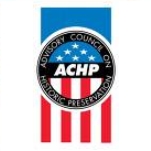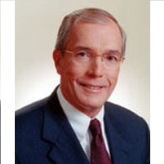ACHP is an independent agency that works with federal, state, local, and tribal governments to address the requirements in Section 106 of the National Historic Preservation Act (NHPA), which mandates their consideration of historic preservation values when planning activities. The ACHP is also the primary policy adviser to the President and Congress on historic preservation issues and it helps carry out the interagency Preserve America Initiative that encourages increased local participation in preserving the country’s cultural and natural heritage assets.
In 1966 the National Historic Preservation Act established ACHP as the first federal entity created solely to focus on historic preservation issues. It was structured to include a combination of federal, state, and local government representatives, experts in the field, and citizens, so the public would be ensured to have a forum for influencing federal policy that impacts historic properties. Since then, Section 106 of the Act, and many others, have been amended, most recently in 2000, to help federal institutions meet the broad goals the original Act put forth. In 1971 Executive Order 11593 required federal agencies, before taking any grant, license or permit actions, to identify properties as historic, based on their being in, or eligible for listing in, the National Register of Historic Places, and to provide ACPH a reasonable amount of time to comment in advance on any historic property undertakings. In 2003 the White House Preserve America (WHPA) initiative added further dimension to the ACHP, including charging it with administering the WHPA program, which recognizes communities that protect and celebrate their local heritage, and overseeing the Preserve America Presidential Awards project that each year gives out four such honors, two for activities advancing heritage tourism and two for privately funded historic preservation projects or programs.
Among the responsibilities of the ACHP:
- Advocate full consideration during federal decision-making of the preservation of historic districts, sites, buildings, structures, and objects.
- Ensure through the Section 106 review process that the public, Indian tribes, and State and local governments have a voice in federal decisions that impact historic properties.
- Monitor problems Indian Tribes and Native Hawaiian organizations confront in adhering to Section 106 requirements, and help develop solutions.
- Use measures, including financial and technical assistance, training, and education to foster conditions under which modern society and prehistoric and historic resources can exist in productive harmony, and fulfill the social, economic, and other requirements of present and future generations.
- Advise the President and Congress on historic preservation issues, and provide suggestions for improving federal policies, programs, planning, and decisions regarding historic and cultural resources.
- Promote intergovernmental cooperation and partnerships for the preservation and use of historic properties, and mediate between local historic preservation interests and federal officials when the government’s activities could adversely affect historical properties.
- Work in a variety of ways to advance the goals of the 2003 White House Preserve America Initiative, including helping educate citizens on the cultural and economic value of historic preservation; expanding participation in Preserve America Communities and Neighborhoods and the Preserve America Presidential Awards Program; develop corporate outreach strategies for engaging businesses; and evaluate and report on a regular basis on the impact of the initiative.
The Historic Preservation Fund was established as part of the NHPA to help fund preservation projects. Congress has authorized up to $150 million to be earmarked for the fund, although that maximum is not met in annual budgets.
ACHP Opposes Wind Energy Project Off Cape Cod
John L. Nau, III
- Table of Contents
- Overview
- History
- What it Does
- Where Does the Money Go
- Controversies
- Suggested Reforms
- Comments
- Leave a comment


In June 2010, President Barack Obama appointed architect Milford Wayne Donaldson to be Chairman of the Advisory Council on Historic Preservation (ACHP), the nation’s lead agency on historic preservation. ACHP is an independent agency that works with federal, state, local, and tribal governments to address the requirements of the 1966 National Historic Preservation Act (NHPA), which mandates consideration of historic preservation values when planning development. The ACHP is also the primary policy advisor to the President and Congress on historic preservation issues and it helps carry out the inter-agency Preserve America Initiative, which encourages increased local participation in preserving the country’s cultural and natural heritage assets. Oddly, Donaldson is the first architect to serve as chair in the 45-year history of ACHP.

- Latest News
- D.C. Public Schools will Teach all Second-Graders to Ride a Bike
- New Rule in Germany Limits Sales of Sex-Themed E-Books to 10pm to 6am
- What Happened to the 6-Year-Old Tibetan Boy the Chinese Government Kidnapped 20 Years Ago?
- U.S. Ambassador to Turkey Photoshops his Hair Color to Mock Turkish Mayor
- Mystery Artist Calls Attention to Unfixed Potholes by Drawing Penises around Them
ACHP is an independent agency that works with federal, state, local, and tribal governments to address the requirements in Section 106 of the National Historic Preservation Act (NHPA), which mandates their consideration of historic preservation values when planning activities. The ACHP is also the primary policy adviser to the President and Congress on historic preservation issues and it helps carry out the interagency Preserve America Initiative that encourages increased local participation in preserving the country’s cultural and natural heritage assets.
In 1966 the National Historic Preservation Act established ACHP as the first federal entity created solely to focus on historic preservation issues. It was structured to include a combination of federal, state, and local government representatives, experts in the field, and citizens, so the public would be ensured to have a forum for influencing federal policy that impacts historic properties. Since then, Section 106 of the Act, and many others, have been amended, most recently in 2000, to help federal institutions meet the broad goals the original Act put forth. In 1971 Executive Order 11593 required federal agencies, before taking any grant, license or permit actions, to identify properties as historic, based on their being in, or eligible for listing in, the National Register of Historic Places, and to provide ACPH a reasonable amount of time to comment in advance on any historic property undertakings. In 2003 the White House Preserve America (WHPA) initiative added further dimension to the ACHP, including charging it with administering the WHPA program, which recognizes communities that protect and celebrate their local heritage, and overseeing the Preserve America Presidential Awards project that each year gives out four such honors, two for activities advancing heritage tourism and two for privately funded historic preservation projects or programs.
Among the responsibilities of the ACHP:
- Advocate full consideration during federal decision-making of the preservation of historic districts, sites, buildings, structures, and objects.
- Ensure through the Section 106 review process that the public, Indian tribes, and State and local governments have a voice in federal decisions that impact historic properties.
- Monitor problems Indian Tribes and Native Hawaiian organizations confront in adhering to Section 106 requirements, and help develop solutions.
- Use measures, including financial and technical assistance, training, and education to foster conditions under which modern society and prehistoric and historic resources can exist in productive harmony, and fulfill the social, economic, and other requirements of present and future generations.
- Advise the President and Congress on historic preservation issues, and provide suggestions for improving federal policies, programs, planning, and decisions regarding historic and cultural resources.
- Promote intergovernmental cooperation and partnerships for the preservation and use of historic properties, and mediate between local historic preservation interests and federal officials when the government’s activities could adversely affect historical properties.
- Work in a variety of ways to advance the goals of the 2003 White House Preserve America Initiative, including helping educate citizens on the cultural and economic value of historic preservation; expanding participation in Preserve America Communities and Neighborhoods and the Preserve America Presidential Awards Program; develop corporate outreach strategies for engaging businesses; and evaluate and report on a regular basis on the impact of the initiative.
The Historic Preservation Fund was established as part of the NHPA to help fund preservation projects. Congress has authorized up to $150 million to be earmarked for the fund, although that maximum is not met in annual budgets.
ACHP Opposes Wind Energy Project Off Cape Cod
John L. Nau, III
Comments


In June 2010, President Barack Obama appointed architect Milford Wayne Donaldson to be Chairman of the Advisory Council on Historic Preservation (ACHP), the nation’s lead agency on historic preservation. ACHP is an independent agency that works with federal, state, local, and tribal governments to address the requirements of the 1966 National Historic Preservation Act (NHPA), which mandates consideration of historic preservation values when planning development. The ACHP is also the primary policy advisor to the President and Congress on historic preservation issues and it helps carry out the inter-agency Preserve America Initiative, which encourages increased local participation in preserving the country’s cultural and natural heritage assets. Oddly, Donaldson is the first architect to serve as chair in the 45-year history of ACHP.

- Latest News
- D.C. Public Schools will Teach all Second-Graders to Ride a Bike
- New Rule in Germany Limits Sales of Sex-Themed E-Books to 10pm to 6am
- What Happened to the 6-Year-Old Tibetan Boy the Chinese Government Kidnapped 20 Years Ago?
- U.S. Ambassador to Turkey Photoshops his Hair Color to Mock Turkish Mayor
- Mystery Artist Calls Attention to Unfixed Potholes by Drawing Penises around Them





Comments